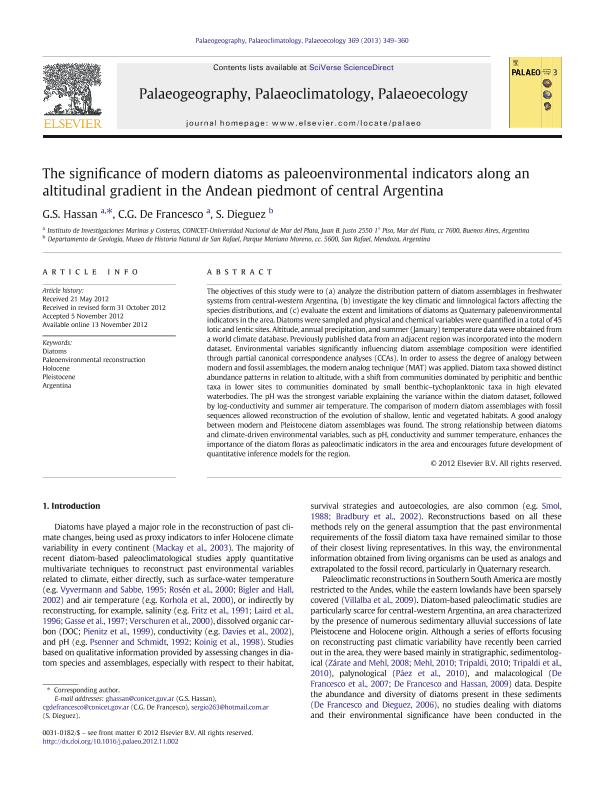Artículo
The significance of modern diatoms as paleoenvironmental indicators along an altitudinal gradient in the Andean piedmont of central Argentina
Fecha de publicación:
01/2013
Editorial:
Elsevier Science
Revista:
Palaeogeography, Palaeoclimatology, Palaeoecology
ISSN:
0031-0182
Idioma:
Inglés
Tipo de recurso:
Artículo publicado
Clasificación temática:
Resumen
The objectives of this study were to (a) analyze the distribution pattern of diatom assemblages in freshwater systems from central-western Argentina, (b) investigate the key climatic and limnological factors affecting the species distributions, and (c) evaluate the extent and limitations of diatoms as Quaternary paleoenvironmental indicators in the area. Diatoms were sampled and physical and chemical variables were quantified in a total of 45 lotic and lentic sites. Altitude, annual precipitation, and summer (January) temperature data were obtained from a world climate database. Previously published data from an adjacent region was incorporated into the modern dataset. Environmental variables significantly influencing diatom assemblage composition were identified through partial canonical correspondence analyses (CCAs). In order to assess the degree of analogy between modern and fossil assemblages, the modern analog technique (MAT) was applied. Diatom taxa showed distinct abundance patterns in relation to altitude, with a shift from communities dominated by periphitic and benthic taxa in lower sites to communities dominated by small benthic?tychoplanktonic <span style="mso-spacerun: yes"> </span>taxa in high elevated waterbodies. The pH was the strongest variable explaining the variance within the diatom dataset, followed by log-conductivity and summer air temperature. The comparison of modern diatom assemblages with fossil sequences allowed reconstruction of the evolution of shallow, lentic and vegetated habitats. A good analogy between modern and Pleistocene diatom assemblages was found. The strong relationship between diatoms and climate-driven environmental variables, such as pH, conductivity and summer temperature, enhances the importance of the diatom floras as paleoclimatic indicators in the area and encourages future development of quantitative inference models for the region.
Palabras clave:
Diatoms
,
Paleoenvironmental Reconstruction
,
Holocene
,
Pleistocene
,
Argentina
Archivos asociados
Licencia
Identificadores
Colecciones
Articulos(IIMYC)
Articulos de INSTITUTO DE INVESTIGACIONES MARINAS Y COSTERAS
Articulos de INSTITUTO DE INVESTIGACIONES MARINAS Y COSTERAS
Citación
Hassan, Gabriela Susana; de Francesco, Claudio German; Dieguez, S.; The significance of modern diatoms as paleoenvironmental indicators along an altitudinal gradient in the Andean piedmont of central Argentina; Elsevier Science; Palaeogeography, Palaeoclimatology, Palaeoecology; 369; 1-2013; 349-360
Compartir
Altmétricas




